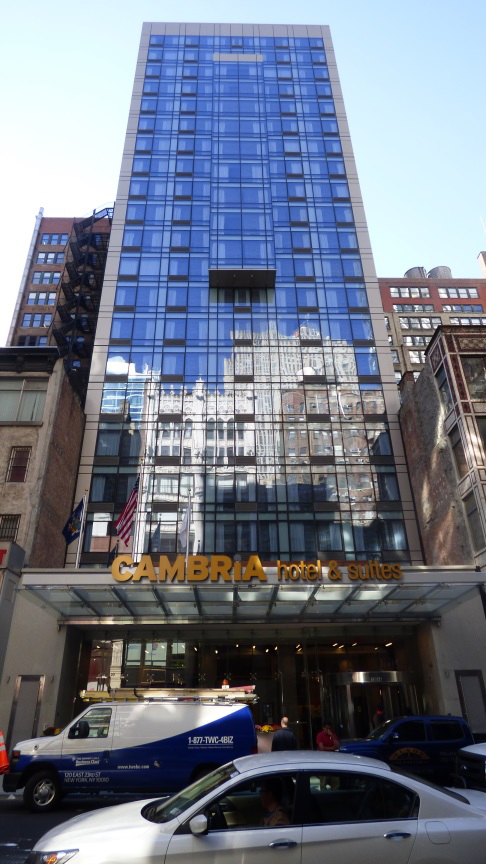News:
Green Buildings
Posted: April 23, 2012
BBS-designed school nominated for Green Ribbon program
NYS commissioner of education John King nominated BBS Architects & Engineers-designed Hampton Bays Middle School to the U.S. Department of Education Green Ribbon Schools program. Hampton Bays Middle is one of only three schools selected by the commissioner from nearly 30 submissions throughout the state. "We are very proud of commissioner King's recognition of our project as one of the leading green schools in the state," said BBS principal architect and lead designer Roger Smith, AIA, LEED AP. "The innovative, healthy and environmentally responsible Hampton Bays Middle School is the result of a very close collaboration among the local community, parents, Hampton Bays Union Free School District and the design team."
Located at 70 Ponquogue Ave., the $42 million, 146,400 s/f structure received the LEED NC 2.1 Silver rating, based on 36 awarded LEED points.
It was the first public school in the entire state to receive any LEED certification. Developed by the U.S. Green Building Council in 2000, LEED, or Leadership in Energy and Environmental Design, is a nationally and internationally recognized third-party, independent review system that verifies that a building, home or community was designed and built using strategies aimed at achieving high performance in key areas of human and environmental health: sustainable site development, water savings, energy efficiency, materials selection and indoor environmental quality.
The U.S. Education Department's Green Ribbon Schools program, established in 2011, recognizes schools that save energy, reduce costs, feature environmentally sustainable learning spaces, protect health, foster wellness, and offer environmental education to boost academic achievement and community engagement. The recognition award is part of a larger effort to identify and disseminate knowledge about practices proven to result in improved student engagement, academic achievement, graduation rates, and workforce preparedness, as well as a government-wide aim to increase energy independence and economic security.
U.S. Education secretary Arne Duncan will announce the winners of the inaugural U.S. Department of Education Green Ribbon Schools competition on Monday, April 23rd, the day after Earth Day.
Hampton Bays Middle is also the first CHPS-certified school in New York State. CHPS, the Collaborative for High Performance Schools, is a national organization that promotes the design and operation of healthy and resource-efficient educational facilities.
The new school houses approximately 800 students in grades five through eight. The building encompasses 30 classrooms and lecture rooms, a competition size gymnasium with seating for 500 spectators, a library/media center, a cafeteria combined with an auditorium and a full theatrical stage, and a home and careers room with six fully equipped kitchen stations. The outdoor sports facilities include field hockey, soccer, softball and football fields.
In addition to Patchogue, NY-based BBS, which served as architect, interior designer and MEP engineer, the project team included architect Beatty Harvey Coco; educational planning consultant DeJong & Associates; construction manager Triton Construction; structural engineer Ysrael A. Seinuk, PC; civil engineer Savik & Murray, LLP; theater consultant Theatrical Services & Supplies; food service/kitchen consultant Wes Design & Supply Company; and environmental consultant Freudenthal & Elkowitz Consulting Group, Inc.
Planning and funding
By the early 2000s, the Hampton Bays Union Free School District was facing a steadily increasing enrollment and the projections indicated this trend would continue. The existing elementary school was occupied at 155% capacity and the secondary school at 135% capacity. The district began planning for an expansion of its facilities as well as renovations and reconfigurations to two existing buildings in order to address the need for more physical space.
The two existing school structures were located on two separate parcels of land within the Hampton Bays community. One site was already fully utilized by the secondary school that served grades seven to twelve, district administration offices, surface parking, and athletic fields. The second site housed the elementary school building situated at the top of a slope along Ponquogue Avenue. Its grounds were organized as a series of terraces stepping down a slope. Play areas extended beyond the school at the same elevation, and then terraced down and away. Field space at this site has been always shared with secondary school athletics and community groups.
Over time, the district purchased parcels of land adjacent to the elementary school's site for potential future development as either new building sites or sports facilities locations. Following the planning analysis and community outreach, the Hampton Bays Public Schools Board of Education opted to use these parcels in conjunction with the elementary school property as the location of a new school building.
The Hampton Bays community was initially most concerned with addressing the issues of "correct-sizing" all K-12 classrooms in accordance with the New York State Education Department's guidelines, implementing a novel "house within a house" concept that aims at creating small communities of students, and expanding the science facilities. The board proposed development of a middle school and extensive renovations and reconfigurations to the existing buildings. This $50.9 million plan was rejected in a bond issue vote, mostly due to the cost.
Following meetings and discussion forums that aimed at identifying reasons for the rejection of the original plan and budget, the board revised its approach and instead proposed limiting the scope to only developing a new middle school, which would have lowered the cost.
During the planning phase for the modified program, however, mold was discovered at the existing elementary school. This finding drastically shifted the direction of the planning process. Although the problem was limited in scope and immediately remediated, the discovery focused the community's attention on the issue of ensuring a healthy indoor environment for the students.
With support from an overwhelming majority of parents, the project team decided that the new middle school would be a very green building. Indoor air quality had become the catalyst and primary objective in the community's mind. The design team reflected those new objectives in its approach: LEED principles would guide the design process.
"This shift had resulted in not only the focus on green design and construction practices, but also in the renewed enthusiasm and acceptance for the project among the community," recalled Smith. "The project team performed a 'design charette' in order to determine the community's design and functional preferences. As a result of this consultation, BBS developed a new floor plan that reflected green principles, while accommodating budgetary restrictions." The designers streamlined and optimized the interior layout in order to keep the anticipated cost down and make the project feasible in the increasingly worsening economic climate. BSS developed a new, LEED-guided design and then preliminary construction estimates.
On March 30, 2004 the Hampton Bays community approved a $42 million bond issue for the construction of the new middle school.
Design
The two-story, 146,400 s/f new middle school building is surrounded by a 28.7-acre site and accommodates approximately 800 students in grades five through eighth.
"During the early planning stage, BBS investigated local historical structures and decided to reflect the regional design tradition in the school's architecture," explained BBS project architect Gary Schiede, AIA, LEED AP. "References to local landmarks, such as the Shinnecock Bay Lighthouse, have been prominently incorporated into the building's design. The lighthouse reference symbolizes both the local maritime history and the guidance provided by an educational structure." The building was limited to two stories in order to fit within the scale of the surrounding neighborhood. The exterior features a brick veneer façade that complements the existing elementary school and window fenestrations that match the vernacular of double hung wood windows.
BBS based its functional design on the learning program developed by the educational planning consultant DeJong & Associates. New York State Middle School Essential Elements Philosophy influenced the educational curriculum.
To meet the needs of middle-level learners, Hampton Bays Middle School offers a traditional academic program supplemented with rich co-curricular and special area offerings that address varying interests, ability-levels, and talents. Program elements include math, English, science, social studies, foreign languages, home and career skills, introduction to technology, public speaking and study skills, physical education and health, computer technology, art education, and instrumental and choral music.
The school features the latest technology that supports learning, access to information, and artistic creativity, including Smart Board systems in every classroom and wireless Internet access throughout the building and the grounds.
"We applied a 'house within a house' educational planning concept that aims at breaking down the perceived scale of a school's interior by dividing it into smaller communities where students can interact on a more intimate level," explained BBS interior designer Tracy Hansen, RA.
According to BBS interior designer Brenna Silveria, CID, LEED AP, "At the Hampton Bays Middle School, the 'houses' are located on each floor of the classroom wings, one for each of the four grades. Students remain within their "houses" except for special classes taking place in dedicated rooms such as music, art and gym. Each house incorporates a centrally located commons area that serves as a public interaction space for students."
The community and the designers' desire to create a healthy interior environment and energy efficient structure, as well as to meet the LEED Silver certification requirements, guided the materials and systems selection process. The architectural and interior design team focused on developing an energy efficient building envelope system; specifying a maximum amount of recycled, recyclable, and renewable materials; ease of maintenance; and mold growth prevention through use of synthetic flooring, CMU walls, and mold resistant gypsum boards. The new middle school features abundant windows that introduce high amounts of natural daylight and improve ventilation.
"BBS and the engineering team achieved a high performance exterior building envelope with a minimal budget impact," recalled BBS project designer Kevin J. Walsh, AIA, LEED AP. "The entire structural frame is enclosed within the insulated building envelope, thereby creating an uninterrupted thermal barrier between the inside and outside of the building. Additional thermal breaks were implemented in floor slabs in order prevent heat loss due to conduction." Three-inch thick insulation within the wall cavity is continuous throughout the entire height of the exterior wall. The walls, windows and roof achieved significantly improved energy efficiency in comparison to the New York State Building Code's baseline standards. Based on the energy modeling analysis, the wall assembly U-values are 113% improved in comparison to the baseline building standard, window U-values are improved by 67% and roof U-values are improved by 96%.
According to BBS project engineer Fred Seeba, PE, LEED AP, "The team also implemented a highly efficient HVAC system. The school's system performs more efficiently than performance standards defined by both ASHRAE 90.1-1999 and the New York State Building Code." According to the modeling analysis, the school reduced the annual energy consumption and the related costs from $420,647 in the baseline settings to $311,143 with the improved wall design and the high-performance HVAC system installed at the new building.
The lighting system for the building consists of hi-lumen, low power T-8 lamps, with T-5 lamps in selected areas. The use of these energy efficient fixtures reduced lighting power density for the majority of the spaces in the building. The classrooms, offices, library and art room feature occupancy sensors. "The cumulative result of the energy conservation measures is the reduction of electricity use of approximately 536,000 kWh per year, equating to more than $90,000 in annual savings," said Seeba.
The project's design was recognized by Long Island Power Authority (LIPA), which awarded the school a $300,000 rebate for energy efficiency measures. LIPA also funded the energy modeling through a grant of $30,000.
The product and material selection process focused on improving the indoor air quality (IAQ) and specifying regionally manufactured materials, preferably with a recycled content. Key IAQ performance criteria included low gas emissions and chemical and pollutant source control. The completed school's IAQ control regime includes air testing of fifteen different zones within the building and individual HVAC controls in each classroom.
As recommended by the US Green Building Council, IAQ control measures also encompassed the construction phase activities. These included storing materials in dry conditions; following the SMACNA dust contamination prevention guidelines during handling and construction of sheet metal, filters, equipment and grilles; maintaining a clean work environment during construction; and extensive air quality testing prior to occupancy. The construction team supported the LEED certification target through detailed tracking and documentation of materials and procedures, and by implementing a construction waste management program that diverted 75% of waste material from landfills to recycling centers for re-use and re-manufacture.
BBS Architects & Engineers
Headquartered in Patchogue, NY, BBS Architects & Engineers is a leading Long Island and NY/NJ/CT Tri-state area designer of sustainable commercial, institutional and public facilities. The firm designed the first LEED-certified public school in New York State Â- the Hampton Bays Middle School in Hampton Bays, NY - which received LEED Silver certification, indicating a very high level of environmental sustainability in design and construction practices. BBS services include architecture and interior design as well as mechanical, electrical and plumbing engineering.
The firm's current and recent work includes the 100-room Hyatt Place East End hotel in Riverhead, NY; the new $28.5-million Life Sciences Building at the Suffolk County Community College Ammerman Campus in Selden, NY; the $78.2-million Riverhead Central School District expansion and capital improvement program in Riverhead, NY; the Holy Sepulchre Cemetery Administrative Building in Coram, NY; and the new Sacred Heart Roman Catholic Church in North Merrick, NY.
***
Tags:
Green Buildings
MORE FROM Green Buildings
IREON Insights: DURA Architectural Signage manufactures and delivers over one million signs
Long Island City, NY Since its founding in 1955, IREON member DURA Architectural Signage has proudly manufactured and delivered more than one million signs to clients across a wide range of industries. From architectural interior signage to large-scale exterior installations, their work can be seen in corporate

Quick Hits







.gif)

.gif)
.jpg)
.gif)